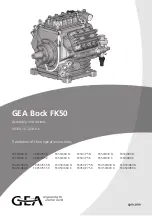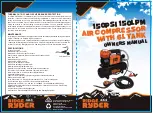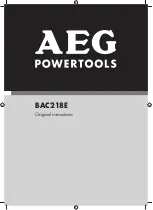
2
Compressor Operation
1
□
□
□
□
□
Draining the tank
Turn off the compressor.
Position a suitable container below the drain valve.
Note: Because condensate is a pollutant, dispose of it in
compliance with local regulations.
Fully open the drain valve (K).
Keep the compressor tilted until all moisture has
been removed.
If the drain valve (K) is clogged, unplug the
compressor and pull the safety valve (C) to remove all air
pressure. Remove and clean the safety valve (C) and then
reinstall it.
Completely close the drain valve (K).
NOTE: Because condensate is a pollutant, dispose of it in
compliance with local regulations.
WARNING: Failure to unplug the air compressor and
depressurize the tank before removing the valve may
cause serious personal injury.
figure
Checking the safety valve
□ Turn on the air compressor and wait for the tank to
fill. The compressor automatically shuts off when the
pressure reaches the preset maximum.
□ Turn off the air compressor.
□ Pull the ring on the safety valve (C) for 20 seconds to
release the air.
□ Release the ring. Air stops escaping at approximately
40-100 psi. If the safety valve dose not reset stop
Dispelling ail between 40-100Psi discontinue use and seek
service before using the air compressor again.
DANGER: Do not tamper with the safety valve. Items
loosened from this device could fly up and hit you.
Failure to heed this warning could result in death or
serious personal injury. The safety valve automatically
releases air when the receiver pressure exceeds the
preset maximum. Check the valve before each day of
use by pulling the ring by hand.
WARNING: If air leaks after releasing the safety valve
ring or if the valve is stuck, do not use the air
compressor until the safety valve has been replaced.
Using the air compressor in this condition could result in
serious personal injury.
7
Please contact
800-514-6729
for further assistanc




























